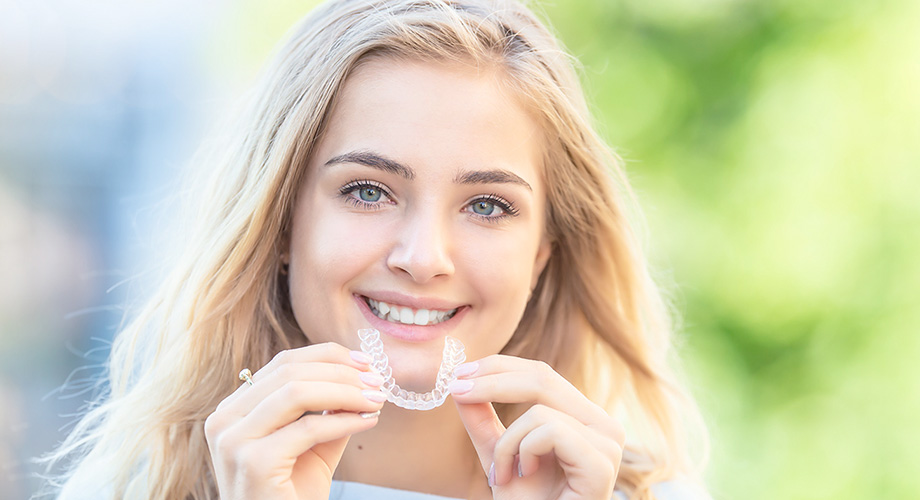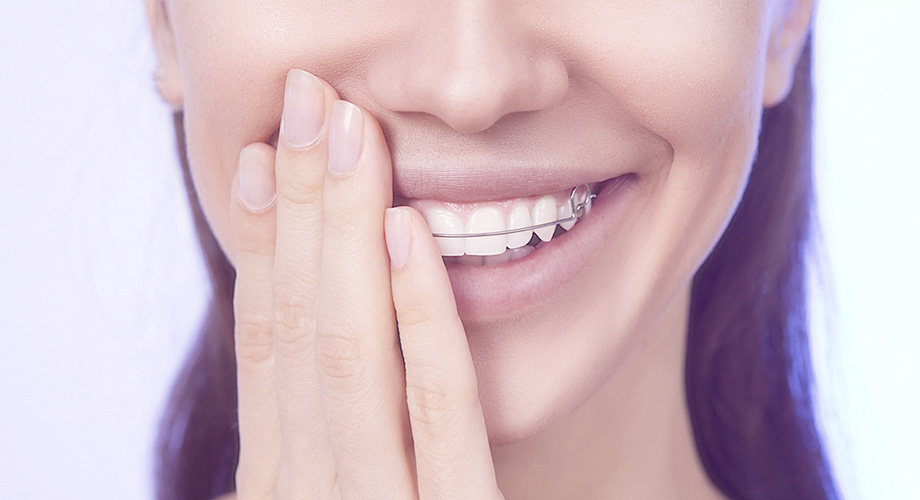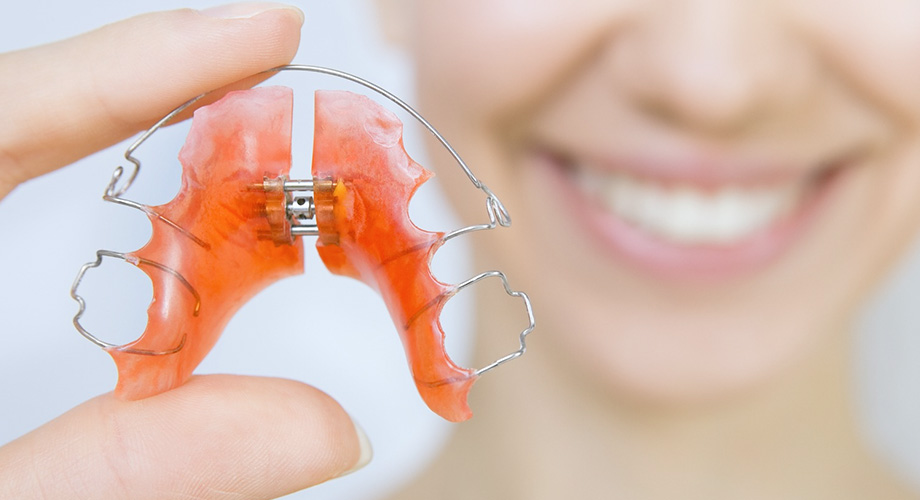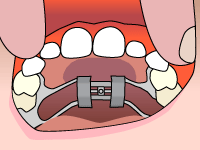Treatment Options
Invisalign® Clear Aligners
Imagine a braces treatment that doesn’t use wires or metal brackets, a treatment that is virtually pain-free and doesn’t require you to change your current lifestyle. With Invisalign aligners, you can straighten your teeth and experience the benefits of a great smile without having to deal with a mouth full of metal! Invisalign treatment uses a series of clear, removable, comfortable aligners that straighten teeth in less time than traditional braces.
Clear Braces
Clear braces are an aesthetic alternative to traditional metal braces. Clear braces are clear, small in size, and customized to fit your teeth and mouth. Clear braces are safe and effective, and are a great option for patients of all ages.
Dentofacial Orthopedics
What is dentofacial orthopedics? Many patients wonder what it means when their orthodontist specializes in dentofacial orthopedics. This specialization means that your doctor has training and experience in working with the management of tooth movement (orthodontics) as well as the guidance of facial growth and development (dentofacial orthopedics), which usually occurs during childhood.
TMJ/TMD Treatments
What is TMJ/TMD and why does it matter to you? Temporomandibular Disorder is a condition where the joints in your jaw become sore and movement is restricted. Millions of Americans suffer from chronic face and neck pains as well as recurring headaches. These can all be signs of a TMD/TMJ condition that may require treatment.
Surgical Orthodontics
Orthodontics is designed to reposition and straighten teeth, but surgical orthodontics may be needed in some cases to correct more severe jaw irregularities. Surgical orthodontics is used to straighten the jaw into alignment, often improving a patient’s ability to chew, speak, and breathe. Braces are often worn in conjunction with orthodontic surgery to make sure the teeth stay in the proper position as well.
Orthodontic Retention
You’ve Worked Hard For Your Beautiful Smile; Keep It That Way!
Finally, your braces have been removed and your smile is beautiful, straight, and best of all, metal-free! However, your orthodontic journey isn’t quite completed. To keep your smile looking its best, you’ll have to wear a retainer to preserve and stabilize your results. Retainers are needed to control or limit potential changes in tooth position. They are used after braces treatment to hold teeth in their correct alignment while the surrounding gums, bone, and muscle adjust to the new positioning of your teeth.
Types of Retainers
Retainers are custom-made and can be removable or fixed.
- Traditional removable retainers typically include a metal wire that surrounds the front teeth and is attached to an acrylic arch that sits in the roof of the mouth. The metal wires can be adjusted to finish treatment and continue minor movement of the front teeth as needed.
- Aligner-style retainers, or Essix retainers, look similar to clear aligners and offer a more aesthetic alternative to wire retainers. This clear retainer may fit over the entire arch of your teeth, or only from canine to canine (clip-on retainer). It is produced from a mold of your newly aligned teeth.
- Fixed retainers consist of wires bonded behind the bottom and/or top teeth. While the device is usually required no more than a year after wisdom teeth have been extracted, it is often kept in place for life.
Pros and Cons
- Removable retainers can be taken out for eating and hygiene routines.
- Removable retainers can get lost easily, so remember to keep yours in the case whenever you remove it to eat or brush.
- A fixed retainer is great if you don’t want to keep track of it, or if you don’t want to worry about how many hours per day it must be worn.
- Teeth with fixed retainers require a little extra attention to remove tartar while flossing. Patients with fixed retainers often must use floss threaders to pass dental floss through the small spaces between the retainer and the teeth.
Palatal Expander
The palatal expander “expands” (or widens) your upper jaw by putting gentle pressure on your upper molars each time an adjustment is made. The animation below will instruct you about when and how to adjust your expander.
When you achieve the desired expansion, you will wear the appliance for several months to solidify the expansion and to prevent regression.
Adjusting The Palatal Expander
You can also download these instructions in a printable PDF document.
Step 1
In a well-lit area, tip the patient’s head back.
Step 2
Place the key in the hole until it is firmly in place.
Step 3
Push the key toward the back of the mouth. You will notice the fender will rotate and the new hole will appear. The rotation stops when the key meets the back of the expander.
Step 4
Press back and down toward the tongue to remove the key. The next hole for insertion of the key should now be visible.
i‐CAT® 3D Imaging
For most people, achieving a healthy, beautiful smile is the reason for receiving orthodontic care. If you’re self-conscious about your smile, correcting your concerns with braces will greatly improve the way you look and feel.
I-Cat Cone Beam 3D Dental Imaging System
The i-CAT Cone Beam 3D Imaging System allows your orthodontist to provide quick, comfortable, and effective imaging for the most precise orthodontic diagnosis possible. i-CAT technology provides 3D data for:
- Orthodontic evaluation and treatment planning
- TMJ treatment
- Airway assessments and sleep apnea
- Full facial and jaw 3D images
Patients can take advantage of a more complete orthodontic treatment with i-CAT imaging. Its innovative features include:
- One 20-second scan that provides your doctor with enough data for a complete diagnosis
- A safer diagnosis with less radiation than traditional CT scanners
- Increased comfort: patients are seated in an open environment with plenty of space
- Doctors can easily share the data with patients, so patients stay informed and are able to make educated decisions on their course of treatment
Our office is pleased to offer i-CAT 3D imaging to our orthodontic patients. Come and see for yourself what it’s like to receive a more advanced, patient-friendly orthodontic experience. Call us today to schedule an appointment.
Clear Braces
Having braces doesn’t necessarily require highly noticeable metal brackets and wires. In fact, many of today’s braces are made from either clear or natural tooth colored materials to provide patients with an attractive, less noticeable alternative to traditional braces.
What Is The Difference Between Clear Braces And Clear Aligners?
Clear braces are the same as traditional metal braces except that they are clear! Clear braces are a less noticeable alternative to traditional metal braces and provide patients with an equally effective treatment.
Clear aligners are different from clear braces. Clear aligners are pieces of hard plastic that are designed to fit into your mouth like a mouthguard. Clear aligners are great for patients requiring minor orthodontic treatment.
What Are The Advantages And Disadvantages To Clear Braces?
As with any orthodontic treatment, it is important to choose the right option for your needs and lifestyle. Clear braces are a great alternative to traditional metal braces and your orthodontist will help you determine whether they are the right treatment for you.
Advantages to clear braces:
- Appearance: Ceramic braces and clear braces are much less noticeable than traditional metal braces. Clear and ceramic braces offer an aesthetic alternative for patients seeking options other than traditional metal braces.
- Confidence: Many patients who choose ceramic or clear braces feel more confident about their orthodontic treatment, especially knowing that people are focusing on their smiles rather than their braces.
Disadvantages to clear braces:
- Cost: Ceramic and clear braces may cost more than traditional metal braces. Your orthodontist may offer convenient payment plans to help control the costs of your treatment. Be sure to talk to your orthodontist about all of your financial options.
- Discoloration: The clear elastic ties used with clear and ceramic braces may become slightly discolored when you drink tea, coffee, or wine, and eat certain foods or smoke. Ask your orthodontist about how you can keep your braces looking their best.
- Treatment Time: Orthodontic treatment with clear or ceramic braces may take longer than with traditional metal braces. If you don’t mind investing a little more time in your smile, then talk to your orthodontist to find out how long your treatment time will be with clear or ceramic braces.
Are Clear Or Ceramic Braces The Right Choice For My Smile And Me?
By talking to your orthodontist, you can decide if clear or ceramic braces are the right treatment for you. Your orthodontist can provide answers to your questions and extra information explaining the benefits of each treatment. If you would like to learn more about clear braces, ceramic braces, and all of the options available to you, please contact our practice and schedule an appointment today.










